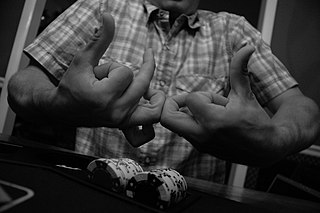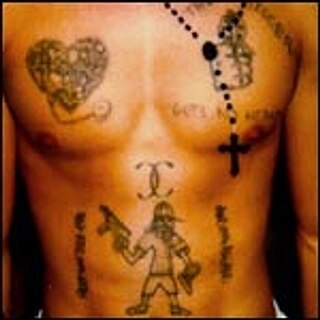
The Bloods are a primarily African-American street gang founded in Los Angeles, California. The gang is widely known for its rivalry with the Crips. It is identified by the red color worn by its members and by particular gang symbols, including distinctive hand signs.

Raymond Lee Washington was an American gangster, known as the founder of the Crips gang in Los Angeles. Washington formed the Crips as a minor street gang in the late 1960s in South Los Angeles, becoming a prominent local crime boss. In 1971, Washington formed an alliance with Stanley "Tookie" Williams, establishing the Crips as the first major African-American street gang in Los Angeles, and served as one of the co-leaders. In 1974, Washington was convicted of robbery and received a five-year prison sentence, during which his leadership and influence in the Crips declined.

Watts is a neighborhood in southern Los Angeles, California. It is located within the South Los Angeles region, bordering the cities of Lynwood, Huntington Park and South Gate to the east and southeast, respectively, and the unincorporated community of Willowbrook to the south.

The 1992 Los Angeles riots were a series of riots and civil disturbances that occurred in Los Angeles County, California, United States, during April and May 1992. Unrest began in South Central Los Angeles on April 29, after a jury acquitted four officers of the Los Angeles Police Department (LAPD) charged with using excessive force in the arrest and beating of Rodney King. The incident had been videotaped by George Holliday, who was a bystander to the incident, and was heavily broadcast in various news and media outlets.
Jordan Downs is a 700-unit public housing apartment complex in Watts, Los Angeles, California, next to David Starr Jordan High School. It consists of 103 buildings with townhouse style units ranging from one bedroom to five bedrooms. The complex is owned and managed by the Housing Authority of the City of Los Angeles (HACLA).

The Rollin 60s Neighborhood Crips is a street gang based in Los Angeles, California, originally formed in Los Angeles in 1976 from the Westside Crips and having since spread to other cities in the United States. Membership is estimated to be around 1,600 people, making it one of the largest gangs in the Los Angeles area.

The Crips are an alliance of street gangs that is based in the coastal regions of Southern California. Founded in Los Angeles, California, in 1969, mainly by Raymond Washington and Stanley Williams, the Crips began as an alliance between two autonomous gangs, and developed into a loosely connected network of individual "sets", often engaged in open warfare with one another. Its members have traditionally worn blue clothing since around 1973.
Andre DeSean Wicker, better known by his stage name Gangsta Dresta, is an American rapper. He is best known for collaborating with Eazy-E on the 1993 single "Real Muthaphuckkin G's".
The Jungles faction of the Black P. Stones street gang is a division ("set") of the Bloods gang alliance in Los Angeles. Originating in Los Angeles' Baldwin Village neighborhood in the 1960s, the Black P. Stones became one of the largest gangs in the city. The gang has been linked to various crimes, including murders, assaults, robberies, narcotics violations and firearms violations, and has been the subject of numerous FBI and LAPD investigations.

Michael Zinzun was an African American Black Panther and anti-police brutality activist.
Crime in Los Angeles has varied throughout time, reaching peaks between the 1970s and 1990s. Since the early 2020s, crime has increased in Los Angeles.
The Watts Gang Task Force is a community-based group that was created to reduce gang related crime in the Watts, Los Angeles, California and improve community-police relations in the area.

Crips and Bloods: Made in America is a 2008 documentary by Stacy Peralta that examines the rise of the Crips and Bloods, prominent gangs in America. The documentary focuses on the external factors that caused African-American youth to turn to gangs and questions the political and law enforcement response to the rise of gang culture.

The Grape Street Watts Crips is a Crip subset based in the Watts neighborhood of Los Angeles. The gang's rivalry with the Bounty Hunter Bloods has been described as being "the most violent and long lasting feud between two gangs that are in the Watts area."
Imam Mujahid Abdul-Karim is an African-American convert to Islam, who is best known for his involvement and "spearheading" of the April 26, 1992 Watts Gang Truce between the four influential rival gangs— Watts Hacienda Village Bloods, Grape Street Watts Crips, Bounty Hunter Watts Bloods, and PJ Watts Crips. He is imam of Masjid Al Rasul mosque in Watts, Los Angeles and the leader of The Imam Mahdi Movement.

The Bounty Hunter Watts Bloods, also known as the Bounty Hunter Bloods, is a predominantly African American street gang situated in the Nickerson Gardens public housing projects in Watts, Los Angeles.
James Hart Stern was an African American Baptist minister, civil rights activist, speaker, and author from Los Angeles, California. He was most well known for his work defusing gang violence through a series of summits in the 1980s and 1990s and for his incarceration with Edgar Ray Killen, the former KKK leader who was convicted of the 1964 Mississippi Burning murders.
The Crips and the Bloods, two street gangs founded in Los Angeles, California, have been in a gang war since the 1970s. The war is made up of smaller, local conflicts perpetrated by chapters of both gangs, and has mostly taken place in major cities in the United States, especially Los Angeles (L.A.). It is also present in other countries, including Belize. The gangs often identify themselves using clothing colored blue for Crips, and red for Bloods; people wearing those colors in gang territory are often targets of violence.
Watts Gang Truce Activists. DeWayne Holmes, Twilight Bey









